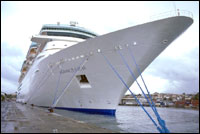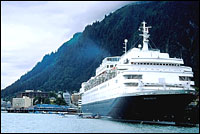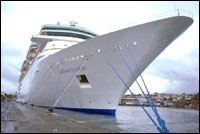Quick — what’s the third-largest city in Alaska?
For all intents and purposes, during the summer, it is the 45,000 people found on the dozens of cruise ships that ply that state’s southeastern coastal waters. And the effects of that “city” on the natural environment are indeed urban, in the worst imaginable ways.
The average cruise passenger produces 10 gallons of concentrated sewage every day. Before I began to read Cruise Ship Blues: The Underside of the Cruise Industry, Ross Klein’s diatribe against pleasure cruises, I had never thought much about what happens to sewage on cruise ships. Few people have — even among environmentalists. That fact in itself underscores how this burgeoning industry has managed to navigate largely beneath the environmental radar screen.
To the extent that I’d thought about sewage on ships at all, I had always assumed that it was kept on board until it could be transferred to some sort of land-based treatment system. If only. The reality, as Klein explains, is that sewage is simply dumped overboard. So are dry cleaning chemicals, kitchen waste, batteries, paint, solvents — everything but oil and plastic. Actually, oil and plastic often do go overboard, but they aren’t supposed to; it’s illegal. Dumping all the rest, however, is perfectly legit, and in some places, it happens within a mile of shore.
And it’s happening on an increasingly vast scale. Cruise lines put the “industry” into “industrial tourism.” Between 1980 and 2000, North American boardings of cruise ships increased 500 percent, to 7 million annually. Worldwide, 12 million cruise boardings were tallied in 2000. (By comparison, about 13 million Americans go skiing or snowboarding each year.) Accommodating this dramatic growth has meant, obviously, putting a lot more cruise ships on the seas. In 1981, the North American cruise industry could handle 41,000 passengers at one time. By 2006, according to Klein, that number will have jumped to 260,000.
Meanwhile, the ships are getting bigger, too. A typical cruise liner in the 1970s (think Love Boat) was built for 700 paying passengers, plus crew. In 1999, Royal Caribbean International christened a 143,000-ton “Eagle-class” ship that carries 5,000 passengers and crew. How big is that? The biggest U.S. aircraft carriers, such as the Abraham Lincoln (upon which President Bush held his recent flight-suit photo-op) weigh a comparatively puny 97,000 tons.
Dock and Cover
Cruise Ship Blues undertakes to indict the leisure cruise industry on several counts: misleading marketing, poor labor practices, poor treatment of guests, and degradation of the environment. I opened it with high expectations, and indeed, some of what Klein finds is damning. Cruise lines have launched several “save the environment” campaigns during the last decade, but it’s tough to regard these as much more than marketing stunts, given that the industry has been fined a combined $33.5 million in recent years for polluting the environment. And that number doesn’t tell the whole story, because in truth, meeting the requirements of the relatively lax laws that govern cruise lines is no guarantee that the environment is being protected. “Many types of discharge from cruise ships are exempt from key regulations under the U.S. Clean Water Act,” Klein reports.

Ships out of shape.
Despite such eye-opening nuggets, I found myself growing increasingly frustrated while reading Cruise Ship Blues. Klein repeatedly nicks at the edges of significant problems with the cruise industry, but the book’s absence of determined investigative journalism, compounded by poor editing, left me exasperated. Cruise Ship Blues seems to have been compiled from three sources: the author’s extensive personal experience as a passenger (he’s taken 30 cruises), anecdotes he collected during these travels, and research of published articles and documents.
What’s missing here is actual reporting. Nothing in Cruise Ship Blues suggests that Klein, an associate professor of social work at Memorial University in Newfoundland, Canada, expended any shoe leather or telephone time to flesh out and verify his anecdotes and assertions. Nowhere in the book, for instance, does he confront anyone from the cruise industry with his charges. Nor, for that matter, does he give the industry’s critics room to speak.
Many of the anecdotes of pollution, poor treatment of staff and guests, and shoddy safety practices are disturbing, but without more context, they fail to tell us anything conclusive about the industry. Ultimately, Cruise Ship Blues was more alarmist than illuminating. More problems in a growing industry isn’t a good thing, but neither is it necessarily an indicator of a worsening situation. In fact, matters could be improving — as they are with airline safety, for instance. Although the total number of airline accidents is much higher today than it was in the 1950s, the rate of accidents per 1,000,000 passenger-miles is much lower, which means that air travel is statistically safer now than it was a half-century ago.
If Klein had used his anecdotes as illustrations within a larger framework instead of as stand-alone criticisms, Cruise Ship Blues would have been much more powerful than it is. Standards of comparison would have been very helpful — perhaps something like “rate of environmental violation per ship afloat.” Likewise, an examination of trends would have been useful: Are ships cleaner or dirtier than they used to be? Is galley-worker pay rising or falling? How much increase has there been in cruise ship miles logged in the Caribbean?
Instead, what the reader is left with is a great deal of personal anecdote that comes across as mere griping: Klein’s stateroom was dirty, the bartenders were rude, the food was bad. Such complaints comprise a flimsy weapon with which to storm the red-carpeted gangways of an increasingly powerful industry.
More problematic is Klein’s affection for innuendo. In one instance, he cites the problem of industrial contaminants poisoning orcas in Alaska and details the alarming quantities of DDT and PCBs found in the bodies of these marine mammals. Then, almost as an afterthought, he writes, “While the cruise industry is not a source of DDT and PCBs, this illustration demonstrates the fragility of the marine environment, and underlines the importance of control over disposal of chemicals and other pollutants at sea.”
Such intellectually flabby incrimination by association does his cause no favors. This book needed an aggressive editor. I’m sure Klein, if pushed, could have come up with powerful examples of the effects of cruise ship pollution on marine ecosystems.
Lost at Sea

A cruise ship docked in Juneau, Alaska.
It’s a pity he didn’t, because he’s almost certainly on to something. As I noted at the beginning of this review, cruise ships are like urban areas — urban areas that visit beautiful and fragile places, with potentially crushing consequences. Klein mentions in passing the story of the village of Tenakee, Alaska, which was visited by its first cruise ship in 1998. Upon disembarking, the passengers were greeted by locals distributing leaflets in protest of the ship’s arrival. This tantalizing tidbit could have made a chapter unto itself. What caused the Tenakee residents to take such a drastic step? Why did they close their businesses and turn their backs on what appeared to be an economic godsend? What did they know that made them so afraid? A few days in Tenakee with a notebook might have produced a rich and powerful story that could have loaned Cruise Ship Blues some of the credibility it lacks.
The way the cruise industry does business has real costs, both human and environmental, and many cruise lines are failing to address this reality. Ships operate under much less stringent environmental and labor laws than most Americans would assume are appropriate, and they are poorly regulated. The cruise industry does a masterful job of hiding this from their clientele. Such a situation cries out for a beefy expose.
Unfortunately, Cruise Ship Blues is not that expose. True, after reading it, I’ll never be able to board a cruise ship and claim naivete about the impacts of doing so. But this book could have had a much larger effect. It could have given the cruise industry a large, public, and perhaps well-deserved black eye. Too bad that Klein didn’t have the follow-through to deliver it.



